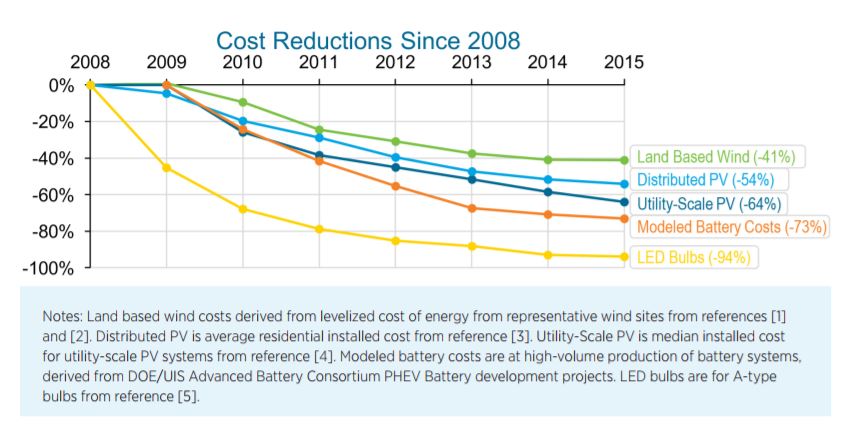From a Department of Energy report entitled Revolution… Now; The Future Arrives for Five Clean Energy Technologies – 2016 Update a nifty graph: (click to embiggen) If the graph is remotely accurate, these are large cost reductions. Accompanying the graph is this verbage: Decades of investments by the federal government and industry in five key clean energy technologies are making an impact today. The cost of land-based wind power, utility and distributed photovoltaic (PV) solar power, light emitting diodes (LEDs), and electric vehicles (EVs) has fallen by 41% to as high as 94% since 2008. These cost reductions have enabled widespread adoption of these technologies with deployment increasing across the board. Combined, wind, utility-scale and distributed
Topics:
Mike Kimel considers the following as important: energy costs, Uncategorized
This could be interesting, too:
tom writes The Ukraine war and Europe’s deepening march of folly
Stavros Mavroudeas writes CfP of Marxist Macroeconomic Modelling workgroup – 18th WAPE Forum, Istanbul August 6-8, 2025
Lars Pålsson Syll writes The pretence-of-knowledge syndrome
Dean Baker writes Crypto and Donald Trump’s strategic baseball card reserve
From a Department of Energy report entitled Revolution… Now; The Future Arrives for Five Clean Energy Technologies – 2016 Update a nifty graph:
(click to embiggen)
If the graph is remotely accurate, these are large cost reductions.
Accompanying the graph is this verbage:
Decades of investments by the federal government and industry in five key clean energy technologies are making
an impact today. The cost of land-based wind power, utility and distributed photovoltaic (PV) solar power, light emitting diodes (LEDs), and electric vehicles (EVs) has fallen by 41% to as high as 94% since 2008. These cost reductions have enabled widespread adoption of these technologies with deployment increasing across the board. Combined, wind, utility-scale and distributed PV accounted for over 66% of all new capacity installed in the nation in 2015. [6] Total installations of LED bulbs have more than doubled from last year, [5] and cumulative EV sales are about to pass the half-million mark. [7]These technologies are now readily available and our country has already begun to reap the benefits through their increased adoption. As these clean technologies are broadly deployed there is a reduction in the emissions that contribute to climate change, the air we breathe is better quality because of a decline in air pollutants, and we are expanding economic opportunities for American workers and manufacturers. In 2014 the manufacturing sectors for wind turbines, photovoltaic panels, lithium ion batteries, and LEDs have added $3.8 billion dollars in value to the U.S. economy. [8]
As we continue to advance international action on climate change under the Paris Agreement – which established a long-term worldwide framework to reduce global greenhouse gas emissions – these five technologies have and will play a critical role in providing opportunities to reach global climate goals. The technologies highlighted in this report exemplify how the clean energy revolution is already underway, is already providing real-world benefits, and continues to promise new solutions on the horizon to address our most pressing energy challenges.
Through the Mission Innovation initiative announced in 2015, 20 countries and the European Union have committed to double their respective clean energy research and development investment over five years. This surge will surely lead to breakthroughs in other clean energy technologies that today still seem futuristic, just as many of the technologies in this report seemed just a few years ago.
We have seen incredible achievements from these technologies, but we must continue to strive to innovate and develop the technologies that remain to be unlocked.
There’s a lot more at the link.

